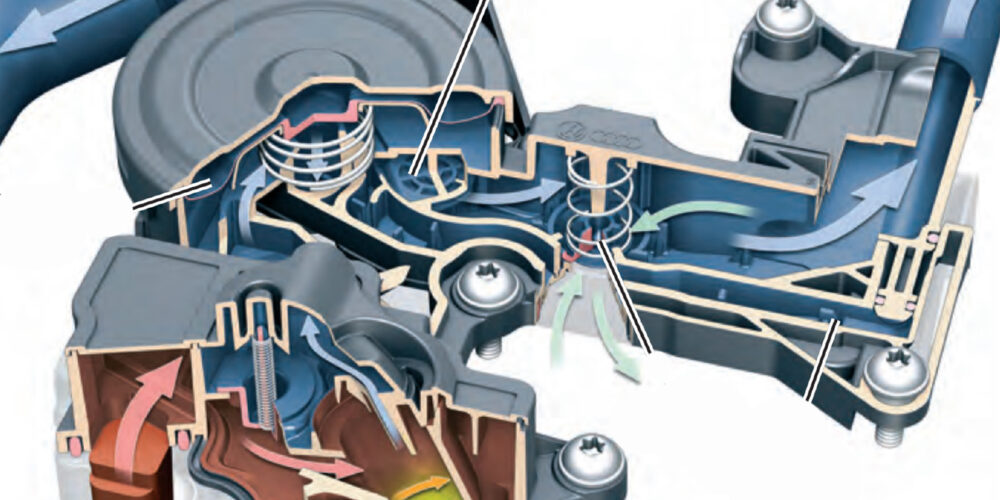Vehicle Application: 2000 Beetle 2.0, 2002 Beetle 1.9, 2002 Golf 1.8, 1999-2003 Golf 2.0, 2000-’05 Jetta 1.8, 1.0, 1999-2005 Jetta 2.0 and 2000-’02 Jetta 2.8
Customer Concern: The A/C is not working. There is no power to the A/C compressor clutch and it does not engage. (Manual climate control.)
Potential Causes: A/C Compressor, A/C Pressure Sensor F129, A/C Switch, Ambient Temperature Switch F38, Battery Auxiliary Fuse Box, Fan Control Module J293 (and Wiring), Fuse or Lost Throttle Basic Settings
Tests/Procedures:
Test the Fan Control (FCM) module inputs as follows:
1. All tests are performed with the ignition key and A/C switched on and the connectors connected to the fan module. The fan control module is located under the radiator and has two connectors: a 14-pin (T14) and a 4-pin (T4).
2. Check for 12 volts to pin T4a/1 (red/black) and T4a/3 (red) via fuses S164 and S180 respectively, in the fuse box on top of the battery, at all times. (Note: It’s critical to check these power sources in a loaded condition as damage to the battery auxiliary fuse box can cause a loss of voltage under load. Visually inspect the condition of the three push-in type fuses for corrosion and burn marks.)
3. Verify an approximate 70% duty cycle from the A/C pressure sensor at pin T14/2 (white) with the ignition on and the compressor not running (duty cycle will decrease as the high-side pressure increases). A duty cycle above 80 or below 10 will command the compressor off and would indicate a faulty pressure sensor, if the compressor is not running and the refrigerant levels are normal.
4. Verify 12 volts to pin T14/4 (red/gray) via fuse 16, at all times.
5. Verify good ground to pin T14/6 (brown/black).
6. When the A/C is switched on and the blower motor is running at any speed, verify that 12 volts from the A/C switch in the instrument panel is available to pin T14/8 (blue/red). Note: The cooling fans should run at low speed whenever the A/C is switched on.
7. Verify 12 volts to pin T14/9 (black/blue) from fuse #5, when the ignition is in the “on” position.
8. Verify the presence of an 11-volt reference (actual voltage reading will oscillate between 7, 9 and 11 volts) at pin T14/13 (purple/yellow). The instrument cluster will ground this reference to request a compressor shutdown for an overheat condition. The cooling fans will also be running on high speed.
9. Disconnect the 14-pin connector. Using a fused 12-volt jumper, apply power to pin T14/10 (green/black). The compressor clutch should engage. If the compressor does not engage, check for a wiring harness open circuit or loss of ground at the compressor. Reconnect the 14-pin connector.
10. Disconnect the 14-pin connector and verify continuity between pin T14/14 (green/blue) and T14/5 (blue/red). This checks the Ambient Temperature Switch (ATS) (normal open circuit below 32° F, continuity above 32° F).
11. Verify the presence of an 11-volt reference voltage at pin T14/3 (green). The engine control module (ECM) will ground this reference to request a compressor shutdown for a wide open throttle (WOT) condition or lack of throttle basic setting. Eleven volts is the normal expected reading at this pin.
12. If all tests pass, the FCM is faulty and must be replaced.
Tech Tips:
Note: Pin T14/3 will be grounded by the ECM if the throttle basic settings are lost. Raising the engine rpm over 2,500 will cause the ECM to allow A/C operation if this is the case. If a ground condition exists on pin 3, perform a throttle basic setting procedure and recheck for correct voltage.
If needed, a repair kit is available from Volkswagen to replace the 14-pin fan control module connector, P/N 6X09737717 KIT.
Courtesy of Identifix.










